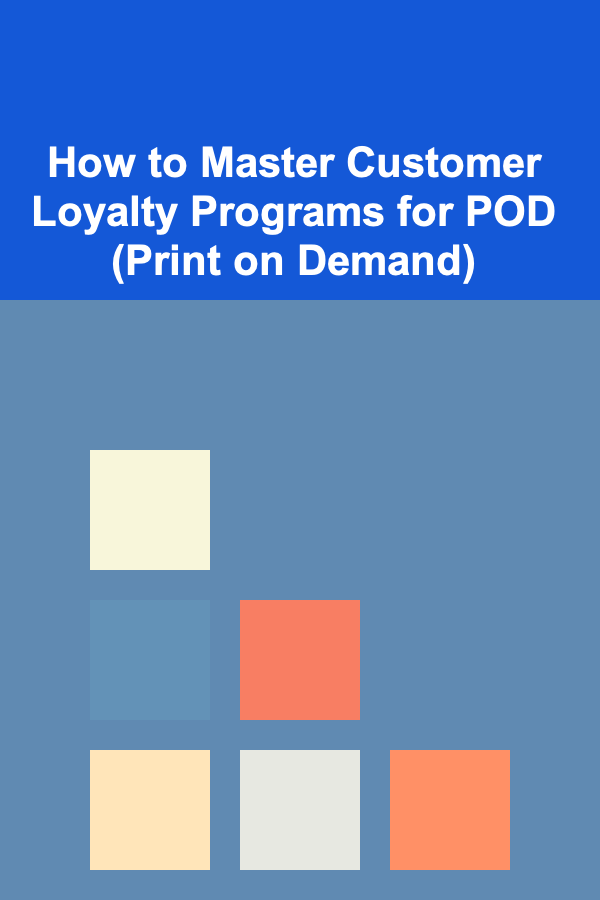
How to Master Customer Loyalty Programs for POD (Print on Demand)
ebook include PDF & Audio bundle (Micro Guide)
$12.99$8.99
Limited Time Offer! Order within the next:

In the rapidly growing world of Print on Demand (POD), where custom products are made on-demand based on customer orders, businesses are finding new ways to stand out and keep customers coming back for more. One of the most effective strategies to achieve this is through the implementation of customer loyalty programs. These programs help build long-term relationships with customers, incentivize repeat purchases, and promote brand advocacy.
Mastering customer loyalty programs for POD can take a business from being just another online shop to a trusted brand that customers consistently return to. In this article, we'll explore the essential strategies and best practices for creating, managing, and optimizing a customer loyalty program that resonates with POD customers and drives sustained business growth.
Understanding Customer Loyalty Programs in POD
A customer loyalty program is a marketing strategy designed to encourage repeat business by rewarding customers for their purchases and engagement. In the context of POD, this could mean offering rewards like discounts, exclusive access to new products, or even free products after a certain number of purchases. The core idea is simple: the more a customer engages with your brand, the more rewards they earn.
For POD businesses, customer loyalty programs are crucial because they can help turn one-time buyers into loyal, repeat customers. Unlike traditional retail models where customers can easily compare prices and offerings, POD businesses typically sell unique, customizable products that create a strong emotional connection with the customer. This emotional connection can be further strengthened through well-designed loyalty programs that offer personalized rewards and recognition.
The Key Benefits of Customer Loyalty Programs in POD
- Increased Customer Retention: The goal of any loyalty program is to increase the likelihood that customers will return for future purchases. This is particularly important in the POD industry, where customer retention can be more challenging due to the wide variety of brands and products available.
- Boosted Average Order Value (AOV): A well-structured loyalty program can incentivize customers to spend more by offering rewards based on their spending. For instance, offering a 10% discount after a customer spends $50 can encourage them to spend just a little more in order to unlock the reward.
- Enhanced Customer Lifetime Value (CLV): By encouraging repeat purchases, a loyalty program can increase the total amount a customer spends over their lifetime. This is a vital metric for POD businesses that often have low margins but rely on volume to drive profitability.
- Brand Advocacy: Loyal customers are often your best promoters. A referral program within your loyalty initiative can help encourage word-of-mouth marketing, which is invaluable for POD businesses, especially in niche markets.
Creating an Effective Customer Loyalty Program for POD
1. Define Clear Goals for the Loyalty Program
Before diving into the design and execution of a loyalty program, it's important to first establish clear objectives. These goals will guide your program's structure and determine the types of rewards you offer. Some key goals to consider include:
- Customer Retention: Focus on rewarding customers for repeat purchases.
- Increased Engagement: Use loyalty programs to incentivize customer interaction with your brand (e.g., social media shares, product reviews, etc.).
- Higher Conversion Rates: Offer incentives that encourage visitors to make a purchase, such as discounts or free shipping on first orders.
2. Understand Your Customer Base
A successful loyalty program must be tailored to the specific preferences of your customers. In the POD industry, customer preferences can vary widely based on product type, niche, and demographic. Conduct research to understand your customer base and identify what type of rewards would resonate with them the most.
- Surveys and Feedback: Use surveys to gather information on what customers value. Are they more interested in discounts, exclusive products, or personalized offers?
- Customer Segmentation: Consider segmenting your customers based on their behavior, such as frequent buyers, occasional shoppers, and first-time customers. This allows you to tailor your loyalty program's offerings.
3. Choose the Right Type of Loyalty Program
There are several types of loyalty programs that can work well for POD businesses. The right type for your brand will depend on your customer base, budget, and goals. Some popular loyalty program models include:
- Points-Based Program: Customers earn points for every purchase or interaction with your brand (e.g., social media engagement, referrals). These points can then be redeemed for discounts, free products, or other rewards.
- Tiered Program: Create multiple levels of rewards where customers unlock better benefits as they reach higher spending thresholds. This motivates customers to spend more in order to access better perks.
- Cashback or Discount Programs: Offer customers a percentage of their purchase price back in the form of a discount or credit toward future purchases. This is straightforward and easy for customers to understand.
- Referral Program: Encourage customers to refer friends and family to your store by rewarding them with points or discounts for each successful referral. This is especially useful for growing your customer base organically.
- Subscription-Based Program: Offer a paid membership that provides ongoing benefits, such as exclusive discounts, free shipping, or early access to new products.
4. Personalize the Loyalty Experience
In the world of POD, customization is key. One of the best aspects of POD businesses is the ability to offer highly personalized products to customers. This can extend to your loyalty program as well. Personalization not only strengthens customer relationships but also enhances the perceived value of your program. Consider the following strategies for personalizing your loyalty program:
- Custom Rewards: Offer rewards that align with customers' previous purchases or preferences. For example, if a customer frequently orders custom t-shirts, offer them a free t-shirt after a certain number of purchases.
- Birthday or Anniversary Rewards: Send personalized offers or rewards based on important dates like birthdays or anniversaries. This adds a personal touch that customers will appreciate.
- Exclusive Access: Offer loyal customers exclusive access to new products or limited-edition items before they are made available to the general public.
5. Ensure a Seamless User Experience
A customer loyalty program must be easy for customers to navigate and participate in. A seamless user experience can help maintain customer interest and engagement with your program.
- Easy Enrollment: Make it simple for customers to join the loyalty program, whether it's through an automatic sign-up during checkout or a one-click registration on your website.
- Clear Communication: Keep customers informed about their rewards, points balance, and progress toward the next tier. Use email notifications, mobile apps, or dashboard features to track and communicate rewards.
- Intuitive Redemption Process: Ensure that redeeming rewards is a hassle-free experience. Customers should be able to apply discounts or claim rewards easily during checkout.
6. Leverage Technology and Automation
Technology plays a key role in the success of loyalty programs. Use software or apps that integrate with your e-commerce platform to automate the tracking and management of customer loyalty. Automation tools can help you:
- Track customer purchases and engagement in real-time.
- Automatically send personalized rewards or incentives.
- Create and manage automated email campaigns for loyalty program updates or exclusive offers.
- Integrate loyalty program features with your POS (point of sale) system to streamline the redemption process.
There are several third-party tools available for setting up and managing loyalty programs, such as Smile.io, LoyaltyLion, and Yotpo. These platforms offer customizable options for POD businesses and integrate seamlessly with e-commerce platforms like Shopify, WooCommerce, and BigCommerce.
7. Promote Your Loyalty Program
Once your loyalty program is live, you need to effectively promote it to your customers. Here are some strategies for boosting program awareness:
- Website Banners and Pop-Ups: Display banners or pop-ups on your website to inform visitors about the benefits of joining the loyalty program.
- Social Media Marketing: Use social media platforms to promote your loyalty program and encourage customers to sign up. Share success stories or testimonials from satisfied customers who've benefited from the program.
- Email Marketing: Send email campaigns to existing customers, informing them of the loyalty program and the rewards they can earn. Make sure the emails are personalized and highlight the program's value.
Best Practices for Maintaining Customer Loyalty in POD
1. Offer Regular Program Updates
Keep your loyalty program fresh by updating rewards and incentives regularly. This keeps the program exciting and ensures that customers don't become disinterested. For instance, introducing seasonal rewards or exclusive collaborations can keep your program engaging.
2. Monitor Program Performance
Regularly track and analyze the performance of your loyalty program. Key metrics to monitor include:
- Customer retention rates
- Average order value (AOV)
- Customer lifetime value (CLV)
- Engagement with rewards (e.g., redemption rates)
Use these insights to adjust your program as needed and optimize its effectiveness.
3. Provide Excellent Customer Support
Customer loyalty is closely tied to the overall customer experience. Ensure that your customers feel valued at every touchpoint by providing exceptional customer service. If a customer has an issue with a reward or redemption, address it quickly and professionally.
4. Collect Feedback and Iterate
Listen to your customers. Solicit feedback on the loyalty program's structure, rewards, and overall experience. Use surveys, reviews, or social media polls to gather opinions and make improvements.
Conclusion
Mastering customer loyalty programs for Print on Demand businesses is a powerful way to build long-term customer relationships, increase sales, and grow your brand. By understanding your customers, creating personalized and engaging rewards, and ensuring a seamless user experience, you can design a loyalty program that resonates with your audience and encourages repeat business. As POD businesses continue to thrive in an increasingly competitive market, customer loyalty programs will be an indispensable tool for success.
Other Products

How to Build a Checklist for Improving Your Emotional Intelligence
Read More
How to Create Zones in Your Dining Room for Different Activities
Read More
How to Maintain a Tidy Kitchen After Cooking
Read More
How to Organize and Store Craft Supplies Efficiently
Read More
How to Store Fitness Equipment in a Small Home Gym
Read More